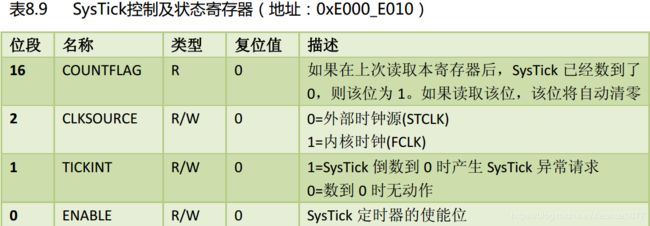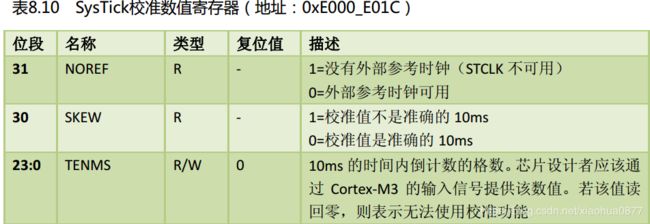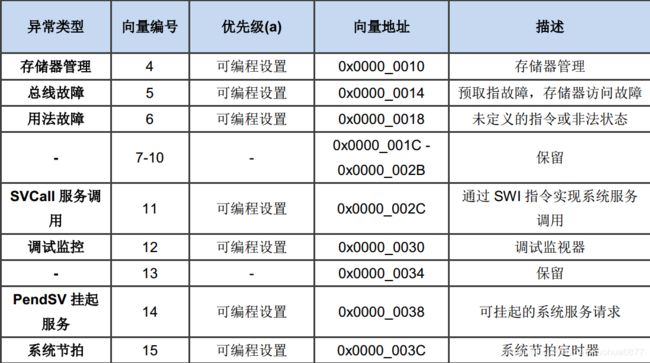【STM32】NVIC与中断控制 之 sysTick定时器
1. 基础概念
SysTick—系统定时器是属于CM4内核中的一个外设,内嵌在NVIC中。系统定时器是一个24bit的向下递减的计数器,计数器每计数一次的时间为1/SYSCLK,一般我们设置系统时钟SYSCLK等于180M。当重装载数值寄存器的值递减到0的时候,系统定时器就产生一次中断,以此循环往复。
因为SysTick是属于CM4内核的外设,所以所有基于CM4内核的单片机都具有这个系统定时器,使得软件在CM4单片机中可以很容易的移植。系统定时器一般用于操作系统,用于产生时基,维持操作系统的心跳。
SysTick定时器被捆绑在NVIC中,用于产生SYSTICK异常(异常号: 15)。在以前,大多操作系统需要一个硬件定时器来产生操作系统需要的滴答中断,作为整个系统的时基。
例如,为多个任务许以不同数目的时间片,确保没有一个任务能霸占系统;或者把每个定时器周期的某个时间范围赐予特定的任务等,还有操作系统提供的各种定时功能,都与这个滴答定时器有关。因此,需要一个定时器来产生周期性的中断,而且最好还让用户程序不能随意访问它的寄存器,以维持操作系统“心跳”的节律。
SysTick定时器能产生中断, CM3为它专门开出一个异常类型,并且在向量表中有它的一席之地。它使操作系统和其它系统软件在CM3器件间的移植变得简单多了,因为在所有CM3产品间对其处理都是相同的。
有4个寄存器控制SysTick定时器,如表8.9至表8.12所示。
1.1 SysTick寄存器介绍
SysTick—系统定时有4个寄存器,简要介绍如下。在使用SysTick产生定时的时候,只需要配置前三个寄存器,最后一个校准寄存器不需要使用
| 寄存器名称 |
寄存器描述 |
| CTRL |
SysTick控制及状态寄存器 |
| LOAD |
SysTick重装载数值寄存器 |
| VAL |
SysTick当前数值寄存器 |
| CALIB |
SysTick校准数值寄存器 |
SysTick控制及状态寄存器
| 位段 |
名称 |
类型 |
复位值 |
描述 |
| 16 |
COUNTFLAG |
R/W |
0 |
如果在上次读取本寄存器后, SysTick 已经计到 |
| 2 |
CLKSOURCE |
R/W |
0 |
时钟源选择位,0=AHB/8,1=处理器时钟AHB |
| 1 |
TICKINT |
R/W |
0 |
1=SysTick倒数计数到 0时产生 SysTick异常请 |
| 0 |
ENABLE |
R/W |
0 |
SysTick 定时器的使能位 |
SysTick 重装载数值寄存器
| 位段 |
名称 |
类型 |
复位值 |
描述 |
| 23:0 |
RELOAD |
R/W |
0 |
当倒数计数至零时,将被重装载的值 |
表 184 SysTick当前数值寄存器
| 位段 |
名称 |
类型 |
复位值 |
描述 |
| 23:0 |
CURRENT |
R/W |
0 |
读取时返回当前倒计数的值,写它则使之清零,同时还会清除在SysTick控制及状态寄存器中的COUNTFLAG 标志 |
SysTick校准数值寄存器
| 位段 |
名称 |
类型 |
复位值 |
描述 |
| 31 |
NOREF |
R |
0 |
NOREF flag. Reads as zero. Indicates that a separate reference clock is provided. |
| 30 |
SKEW |
R |
1 |
SKEW flag: Indicates whether the TENMS value is exact. Reads as one. Calibration |
| 23:0 |
TENMS |
R |
0 |
Calibration value. Indicates the calibration value when the SysTick counterruns on HCLK max/8 as external clock. The value is product dependent, please refer to theProduct Reference Manual, SysTick Calibration Value section. When HCLK is programmed atthe maximum frequency, the SysTick period is 1ms. |
系统定时器的校准数值寄存器在定时实验中不需要用到。有关各个位的描述这里引用手册里面的英文版本,比较晦涩难懂,暂时不知道这个寄存器用来干什么。有研究过的朋友可以交流,起个抛砖引玉的作用。
表8.9 SysTick控制及状态寄存器(地址:0xE000_E010)

2.0 芯片介绍
分别为200 MHz/100 MHz/50 MHz。 RCU通过AHB时钟(HCLK)8分频后作为Cortex系统定时器(SysTick)的外部时钟。通过对SysTick控制和状态寄存器的设置,可选择上述时钟或AHB(HCLK)时钟作为SysTick时钟。
SysTick校准值设为25000, SysTick时钟频率配置为HCLK/8,此时若HCLK时钟被配置为200MHz,则SysTick中断会1ms响应一次。
2.0 SysTick定时实验
利用SysTick产生1s的时基,LED以1s的频率闪烁
/**
\brief System Tick Configuration
\details Initializes the System Timer and its interrupt, and starts the System Tick Timer.
Counter is in free running mode to generate periodic interrupts.
\param [in] ticks Number of ticks between two interrupts.
\return 0 Function succeeded.
\return 1 Function failed.
\note When the variable __Vendor_SysTickConfig is set to 1, then the
function SysTick_Config is not included. In this case, the file device.h
must contain a vendor-specific implementation of this function.
*/
__STATIC_INLINE uint32_t SysTick_Config(uint32_t ticks)
{
if ((ticks - 1UL) > SysTick_LOAD_RELOAD_Msk)
{
return (1UL); /* Reload value impossible */
}
SysTick->LOAD = (uint32_t)(ticks - 1UL); /* set reload register */
NVIC_SetPriority (SysTick_IRQn, (1UL << __NVIC_PRIO_BITS) - 1UL);
/* set Priority for Systick Interrupt */
SysTick->VAL = 0UL; /* Load the SysTick Counter Value */
SysTick->CTRL = SysTick_CTRL_CLKSOURCE_Msk |
SysTick_CTRL_TICKINT_Msk |
SysTick_CTRL_ENABLE_Msk;
/* Enable SysTick IRQ and SysTick Timer */
return (0UL);
/* Function successful */
}void SystemClock_Config(void)
{
/* Set FLASH latency */
LL_FLASH_SetLatency(LL_FLASH_LATENCY_7);
/* Enable PWR clock */
LL_APB1_GRP1_EnableClock(LL_APB1_GRP1_PERIPH_PWR);
/* Activation OverDrive Mode */
LL_PWR_EnableOverDriveMode();
/* Activation OverDrive Switching */
LL_PWR_EnableOverDriveSwitching();
/* Main PLL configuration and activation */
LL_RCC_PLL_ConfigDomain_SYS(LL_RCC_PLLSOURCE_HSI, LL_RCC_PLLM_DIV_16, 432, LL_RCC_PLLP_DIV_2);
LL_RCC_PLL_Enable();
/* Sysclk activation on the main PLL */
LL_RCC_SetAHBPrescaler(LL_RCC_SYSCLK_DIV_1);
LL_RCC_SetSysClkSource(LL_RCC_SYS_CLKSOURCE_PLL);
/* Set APB1 & APB2 prescaler*/
LL_RCC_SetAPB1Prescaler(LL_RCC_APB1_DIV_4);
LL_RCC_SetAPB2Prescaler(LL_RCC_APB2_DIV_2);
/* Set systick to 1ms */
SysTick_Config(216000000 / 1000);
/* Update CMSIS variable (which can be updated also through SystemCoreClockUpdate function) */
SystemCoreClock = 216000000;
}/* SystemFrequency / 1000 1ms中断一次
* SystemFrequency / 100000 10us中断一次
* SystemFrequency / 1000000 1us中断一次
*/
if (SysTick_Config(SystemCoreClock / 100000)) {
}SysTick初始化函数由用户编写,里面调用了SysTick_Config()这个固件库函数,通过设置该固件库函数的形参,就决定了系统定时器经过多少时间就产生一次中断。
2.1 SysTick中断时间的计算
SysTick定时器的计数器是向下递减计数的,计数一次的时间TDEC=1/CLKAHB,当重装载寄存器中的值VALUELOAD减到0的时候,产生中断,可知中断一次的时间TINT=VALUELOAD * TDEC中断= VALUELOAD/CLKAHB,其中CLKAHB =180MHZ。如果设置为180,那中断一次的时间TINT=180/180M=1us。不过1us的中断没啥意义,整个程序的重心都花在进出中断上了,根本没有时间处理其他的任务。
SysTick_Config(SystemCoreClock / 100000))
SysTick_Config()的形我们配置为SystemCoreClock / 100000=180M/100000=1800,从刚刚分析我们知道这个形参的值最终是写到重装载寄存器LOAD中的,从而可知我们现在把SysTick定时器中断一次的时间TINT=1800/180M=10us。
2.2 SysTick定时时间的计算
当设置好中断时间TINT后,我们可以设置一个变量t,用来记录进入中断的次数,那么变量t乘以中断的时间TINT就可以计算出需要定时的时间。
2.3 SysTick定时函数
现在我们定义一个微秒级别的延时函数,形参为nTime,当用这个形参乘以中断时间TINT就得出我们需要的延时时间,其中TINT我们已经设置好为10us。关于这个函数的具体调用看注释即可。
2.4 systick 微秒级延时
//代码 183 systick 微秒级延时
void SysTick_Delay_Us(__IO uint32_t us)
{
uint32_t i;
SysTick_Config(SystemCoreClock / 1000000);
for (i = 0; i < us; i++)
{
// 当计数器的值减小到0的时候,CRTL寄存器的位16会置1
while (!((SysTick->CTRL) & (1 << 16)));
}
// 关闭SysTick定时器
SysTick->CTRL &= ~SysTick_CTRL_ENABLE_Msk;
}2.5systick 毫秒级延时
//代码 184 systick 毫秒级延时
void SysTick_Delay_Ms(__IO uint32_t ms)
{
uint32_t i;
SysTick_Config(SystemCoreClock / 1000);
for (i = 0; i < ms; i++)
{
// 当计数器的值减小到0的时候,CRTL寄存器的位16会置1
// 当置1时,读取该位会清0
while (!((SysTick->CTRL) & (1 << 16)));
}
// 关闭SysTick定时器
SysTick->CTRL &= ~ SysTick_CTRL_ENABLE_Msk;
}2.6 结构体
/**
\brief Structure type to access the System Timer (SysTick).
*/
typedef struct
{
__IOM uint32_t CTRL; /*!< Offset: 0x000 (R/W) SysTick Control and Status Register */
__IOM uint32_t LOAD; /*!< Offset: 0x004 (R/W) SysTick Reload Value Register */
__IOM uint32_t VAL; /*!< Offset: 0x008 (R/W) SysTick Current Value Register */
__IM uint32_t CALIB; /*!< Offset: 0x00C (R/ ) SysTick Calibration Register */
} SysTick_Type;
/* SysTick Control / Status Register Definitions */
#define SysTick_CTRL_COUNTFLAG_Pos 16U /*!< SysTick CTRL: COUNTFLAG Position */
#define SysTick_CTRL_COUNTFLAG_Msk (1UL << SysTick_CTRL_COUNTFLAG_Pos) /*!< SysTick CTRL: COUNTFLAG Mask */
#define SysTick_CTRL_CLKSOURCE_Pos 2U /*!< SysTick CTRL: CLKSOURCE Position */
#define SysTick_CTRL_CLKSOURCE_Msk (1UL << SysTick_CTRL_CLKSOURCE_Pos) /*!< SysTick CTRL: CLKSOURCE Mask */
#define SysTick_CTRL_TICKINT_Pos 1U /*!< SysTick CTRL: TICKINT Position */
#define SysTick_CTRL_TICKINT_Msk (1UL << SysTick_CTRL_TICKINT_Pos) /*!< SysTick CTRL: TICKINT Mask */
#define SysTick_CTRL_ENABLE_Pos 0U /*!< SysTick CTRL: ENABLE Position */
#define SysTick_CTRL_ENABLE_Msk (1UL /*<< SysTick_CTRL_ENABLE_Pos*/) /*!< SysTick CTRL: ENABLE Mask */
/* SysTick Reload Register Definitions */
#define SysTick_LOAD_RELOAD_Pos 0U /*!< SysTick LOAD: RELOAD Position */
#define SysTick_LOAD_RELOAD_Msk (0xFFFFFFUL /*<< SysTick_LOAD_RELOAD_Pos*/) /*!< SysTick LOAD: RELOAD Mask */
/* SysTick Current Register Definitions */
#define SysTick_VAL_CURRENT_Pos 0U /*!< SysTick VAL: CURRENT Position */
#define SysTick_VAL_CURRENT_Msk (0xFFFFFFUL /*<< SysTick_VAL_CURRENT_Pos*/) /*!< SysTick VAL: CURRENT Mask */
/* SysTick Calibration Register Definitions */
#define SysTick_CALIB_NOREF_Pos 31U /*!< SysTick CALIB: NOREF Position */
#define SysTick_CALIB_NOREF_Msk (1UL << SysTick_CALIB_NOREF_Pos) /*!< SysTick CALIB: NOREF Mask */
#define SysTick_CALIB_SKEW_Pos 30U /*!< SysTick CALIB: SKEW Position */
#define SysTick_CALIB_SKEW_Msk (1UL << SysTick_CALIB_SKEW_Pos) /*!< SysTick CALIB: SKEW Mask */
#define SysTick_CALIB_TENMS_Pos 0U /*!< SysTick CALIB: TENMS Position */
#define SysTick_CALIB_TENMS_Msk (0xFFFFFFUL /*<< SysTick_CALIB_TENMS_Pos*/) /*!< SysTick CALIB: TENMS Mask */
//\Drivers\CMSIS\Include\core_cm7.h
/* Memory mapping of Cortex-M4 Hardware */
#define SCS_BASE (0xE000E000UL) /*!< System Control Space Base Address */
#define ITM_BASE (0xE0000000UL) /*!< ITM Base Address */
#define DWT_BASE (0xE0001000UL) /*!< DWT Base Address */
#define TPI_BASE (0xE0040000UL) /*!< TPI Base Address */
#define CoreDebug_BASE (0xE000EDF0UL) /*!< Core Debug Base Address */
#define SysTick_BASE (SCS_BASE + 0x0010UL) /*!< SysTick Base Address */
#define NVIC_BASE (SCS_BASE + 0x0100UL) /*!< NVIC Base Address */
#define SCB_BASE (SCS_BASE + 0x0D00UL) /*!< System Control Block Base Address */
#define SCnSCB ((SCnSCB_Type *) SCS_BASE ) /*!< System control Register not in SCB */
#define SCB ((SCB_Type *) SCB_BASE ) /*!< SCB configuration struct */
#define SysTick ((SysTick_Type *) SysTick_BASE ) /*!< SysTick configuration struct */
#define NVIC ((NVIC_Type *) NVIC_BASE ) /*!< NVIC configuration struct */
#define ITM ((ITM_Type *) ITM_BASE ) /*!< ITM configuration struct */
#define DWT ((DWT_Type *) DWT_BASE ) /*!< DWT configuration struct */
#define TPI ((TPI_Type *) TPI_BASE ) /*!< TPI configuration struct */
#define CoreDebug ((CoreDebug_Type *) CoreDebug_BASE) /*!< Core Debug configuration struct */


